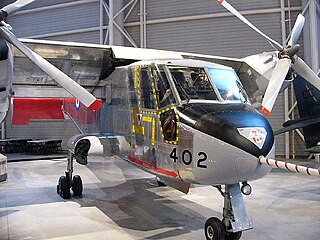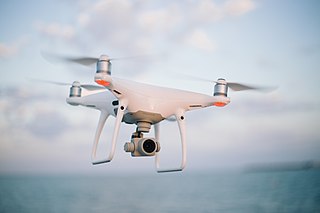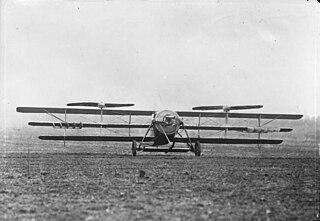Related Research Articles

Rotary Rocket Company was a rocketry company that developed the Roton concept in the late 1990s as a fully reusable single-stage-to-orbit (SSTO) crewed spacecraft. The design was initially conceived by Bevin McKinney, who shared it with Gary Hudson. In 1996, Rotary Rocket Company was formed to commercialize the concept. The Roton was intended to reduce costs of launching payloads into low Earth orbit by a factor of ten.

The Bell XV-15 is an American tiltrotor VTOL aircraft. It was the second successful experimental tiltrotor aircraft and the first to demonstrate the concept's high speed performance relative to conventional helicopters.

The Mil V-12, given the project number Izdeliye 65, is a prototype helicopter designed in the Soviet Union and the largest helicopter ever built. The designation "Mi-12" would have been the designation for the production helicopter and did not apply to V-12 prototypes.

The Canadair CL-84 "Dynavert", designated by the Canadian Forces as the CX-131, was a V/STOL turbine tiltwing monoplane designed and manufactured by Canadair between 1964 and 1972. Only four of these experimental aircraft were built, with three entering flight testing. Two of the CL-84s crashed due to mechanical failures, with no fatalities in either accident. Despite the CL-84 being successful in the experimental and operational trials carried out between 1972 and 1974, none of the prospective customers placed any orders for the type.

A quadcopter, also called quadrocopter, or quadrotor is a type of helicopter or multicopter that has four rotors.

The Igor I. Sikorsky Human Powered Helicopter Competition was established in 1980 by the American Helicopter Society (AHS) International. The award, the AHS Sikorsky Prize, was given for the first human powered helicopter (HPH) to meet a set of extremely challenging flight requirements. In summary, the requirements to win the AHS Sikorsky Prize included a flight duration of 60 seconds and reaching an altitude of 3 meters, with the center point of the aircraft hovering over a 10-by-10-metre square.

A human-powered helicopter (HPH) is a helicopter powered solely by one or more humans carried on board. As in other human-powered aircraft, the power is usually generated by pedalling. It remains a considerable engineering challenge to obtain both the power-to-weight ratio and rotor efficiency required to sustain a helicopter in flight.

The Sikorsky S-69 is an American experimental compound helicopter developed by Sikorsky Aircraft as the demonstrator of the co-axial Advancing Blade Concept (ABC) with United States Army and NASA funding.

A helicopter is a type of rotorcraft in which lift and thrust are supplied by horizontally spinning rotors. This allows the helicopter to take off and land vertically, to hover, and to fly forward, backward and laterally. These attributes allow helicopters to be used in congested or isolated areas where fixed-wing aircraft and many forms of short take-off and landing (STOL) or short take-off and vertical landing (STOVL) aircraft cannot perform without a runway.

The Cessna CH-1 Skyhook is the only helicopter ever built by the Cessna Aircraft Company. It was the first helicopter to land on the summit of Pike's Peak and the last piston-engined helicopter to set the helicopter altitude record. The CH-1 had a single, two-bladed main rotor, and a front-mounted reciprocating engine which gave the aircraft a stable center of gravity (CG). Its semi-monocoque airframe greatly resembles its light airplane siblings built by Cessna. The CH-1 was named Skyhook for the civil market, similar to the marketing names used in the Cessna single engine airplane line, such as Skyhawk, Skylane and Skywagon. The United States Army designated the CH-1C as the YH-41 Seneca. While the CH-1 achieved several helicopter firsts and set a world record, it never became a commercial or military success.

The Fairey FB-1 Gyrodyne is an experimental British rotorcraft that used single lifting rotor and a tractor propeller mounted on the tip of the starboard stub wing to provide both propulsion and anti-torque reaction.

The McDonnell XV-1 is an experimental Convertiplane developed by McDonnell Aircraft for a joint research program between the United States Air Force and the United States Army to explore technologies to develop an aircraft that could take off and land like a helicopter but fly at faster airspeeds, similar to a conventional airplane. The XV-1 would reach a speed of 200 mph, faster than any previous rotorcraft, but the program was terminated due to the tip-jet noise and complexity of the technology which gave only a modest gain in performance.

The de Bothezat helicopter, also known as the Jerome-de Bothezat Flying Octopus, was an experimental quadrotor helicopter built for the United States Army Air Service by George de Bothezat in the early 1920s, and was said at the time to be the first successful helicopter. Although its four massive six-bladed rotors allowed the craft to fly successfully, it suffered from complexity, control difficulties, and high pilot workload, and was reportedly only capable of forward flight in a favorable wind. The Army canceled the program in 1924, and the aircraft was scrapped.

The Sikorsky S-97 Raider is a high-speed scout and attack compound helicopter based on the Advancing Blade Concept (ABC) with a coaxial rotor system under development by Sikorsky Aircraft. Sikorsky planned to offer it for the United States Army's Armed Aerial Scout program, along with other possible uses. The S-97 made its maiden flight on 22 May 2015.

The Berliner Helicopter is a series of experimental helicopters built by Henry Berliner between 1922 and 1925. The helicopters had only limited controllability but were the most significant step forward in helicopter design in the US, until the production of the Vought-Sikorsky VS-300 helicopter in 1940. The 1922 flights of the Berliner and the de Bothezat H1 were the first by manned helicopters.

The University of Maryland Gamera I is a human-powered helicopter designed to win the $250,000 Sikorsky Prize.
The University of Maryland Gamera II is an improved human-powered helicopter designed to win the US$250,000 Sikorsky Prize.

The AeroVelo Atlas is a human-powered helicopter (HPH) that was built for AHS International's Igor I. Sikorsky Human Powered Helicopter Competition. On 13 June 2013, it became the first aircraft to achieve the goals of the competition and thus won the prize.
The TechHaus Volantis is an American electric-powered hover vehicle commissioned by pop star Lady Gaga as a "flying dress" in support of her 2013 album Artpop.
The Vertigo was a human-powered helicopter designed and built in the 1980s by Andrew Cranfield, an engineer with Westland Helicopters.
References
- 1 2 3 4 5 6 Nagaraj, Vengalattore T.; Chopra, Inderjit & Pines, Darryll J. (2021). Gamera: A Human Powered Helicopter – In Pursuit of an Aviation Milestone. Reston, Virginia: American Institute of Aeronautics and Astronautics, Inc. pp. 140–142. ISBN 9781624106200.
- 1 2 3 SM Staff (October 10, 2016). "World's First Solar-Powered Helicopter Solar Gamera Passed First Flight". Solar Magazine. Archived from the original on October 20, 2017. Retrieved June 18, 2023.
- 1 2 "University of Maryland Achieves First Flight of a Solar-Powered, Piloted Helicopter". Department of Aerospace Engineering. University of Maryland. September 7, 2016. Archived from the original on February 6, 2023. Retrieved June 18, 2023.
- ↑ Gamera Solar Unveiling (YouTube video). TeamGameraHPH. June 13, 2017. Event occurs at 3:15.